Find more information in the General Comments section of the assessment
Find more information in the Rating Validity tab of the assessment
- See More
- See More
- See More
- See More
- Good
- Adequate
- Marginal
- Weak
- Poor
 Passenger
Passenger
 Driver
Driver
 Rear Seat
Rear Seat
 Front Seat
Front Seat
 Car
Car
 Pole
Pole
- Good
- Adequate
- Marginal
- Weak
- Poor


Passenger
outboard
center
Fitted to the vehicle as standard
Not fitted to the test vehicle but available as option
Not Available
-
Infants up to 13 kg
-
Infants and toddlers up to 18 kg
-
Toddlers from 9 to 18 kg
-
Toddlers over 18 kg
Easy
Difficult
Safety critical
Not allowed
| Seat Position | ||||
|---|---|---|---|---|
| Front | 2nd row | |||
| Passenger | Left | center | Right | |
| Maxi Cosi Cabriofix (Belt) | ||||
| Britax Römer King Plus (Belt) | ||||
| Britax Römer Duo Plus (ISOFIX) | ||||
| Britax Römer KidFix (Belt) | ||||
| Maxi Cosi Cabriofix & EasyFix (Belt) | ||||
| Maxi Cosi Cabriofix & EasyFix (ISOFIX) | ||||
| BeSafe iZi Kid X3 ISOfix (ISOFIX) | ||||
| Maxi Cosi Pearl & Familyfix (ISOFIX) | ||||
| Britax Römer KidFix (ISOFIX) | ||||
Easy
Difficult
Safety critical
Not allowed
Based on dummy readings in the dynamic crash tests, the Mondeo scored maximum points for its protection of the 1½ year dummy, sat in a rearward-facing restraint. In the frontal impact, forward movement of the head of the 3 year dummy, sat in a forward-facing restraint, was not excessive but marginally elevated neck forces lost the car a fraction of a point. In the side impact test, both dummies were properly contained within the protective shells of their restraints, minimising the likelihood of dangerous head contact with the vehicle interior. The front passenger airbag can be deactivated to allow a rearward-facing child restraint to be used in that seating position. Clear information is provided to the driver regarding the status of the airbag and the system was rewarded. All of the restraint types for which the car is designed could be properly installed and accommodated in the car except for the universal group II/III restraint which could not be stably installed in the rear centre seating position. The Mondeo lost some points because the universal group 0+/1 seats should not be used in the rear outboard seats if optional seatbelt airbags are fitted.
- Good
- Adequate
- Marginal
- Weak
- Poor

Head Impact 17.9 Pts
Pelvis Impact 0.0 Pts
Leg Impact 6.0 Pts
The bumper scored maximum points for its protection of pedestrians' legs, and scored maximum points. However, the front edge of the bonnet scored no points, providing poor protection to the pelvis region. Tests on the bonnet surface revealed predominantly good or adequate levels of protection to the head of a struck pedestrian, with poor results recorded only on the stiff windscreen pillars. Ford's autonomous emergency braking system is available as an option and can detect pedestrians as well as other vehicles, helping to avoid or to mitigate injuries to pedestrians and other vulnerable road users. As the system is not standard equipment, it was not included in the assessment.
- Good
- Adequate
- Marginal
- Weak
- Poor
| Speed Limit Information Function | Camera |
| Speed Limitation Function | Manually Set |
| System Name | ESP | |
| Performance | ||
| Applies To | All seats | ||
| Warning | Driver Seat | Front Passenger(s) | Rear Passenger(s) |
| Visual | |||
| Audible | |||
|
|||
| Type | Lane Keep Assist |
| Performance | |
|
LDW Confirmation Test
|
Pass |
Electronic stability control is standard equipment on the Mondeo, together with a seatbelt reminder for the front and rear seats. A combined lane departure warning/lane keeping assistance system is an option. It is expected to be fitted to most cars sold so it was included in the assessment and met Euro NCAP's requirements. A camera-based sign recognition system provides information about the relevant speed limit to the driver who can then set the speed limiter appropriately. An autonomous emergency braking system is available that works from low, city-type speeds to the higher speeds typical of open-road driving. The system is not expected to meet fitment requirements so it was not included in the assessment.
- Specifications
- Safety Equipment
- Videos
- Rating Validity
Specifications
Tested Model Ford Mondeo 2.0 diesel 'Trend/Wagon', LHD
Body Type - 5 door wagon
Year Of Publication 2014
Kerb Weight 1634kg
VIN From Which Rating Applies - applies to all Mondeos of the specification tested
Class Large Family Car
Safety Equipment
Note: Other equipment may be available on the vehicle but was not considered in the test year.
Fitted to the vehicle as standard
Fitted to the vehicle as option
Not fitted to the test vehicle but available as option
Not Available
Not Applicable
Videos
Rating Validity







Find more information in the General Comments section of the assessment
 Share
Share
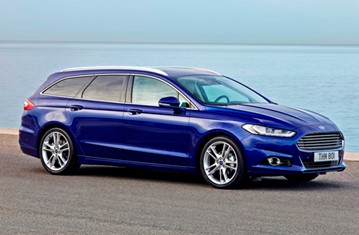


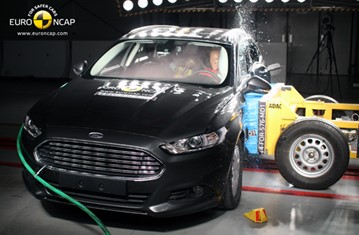
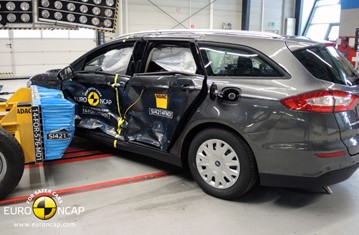
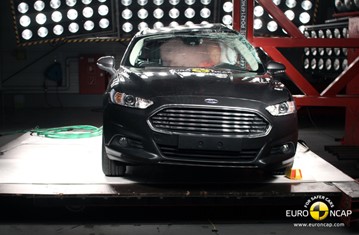
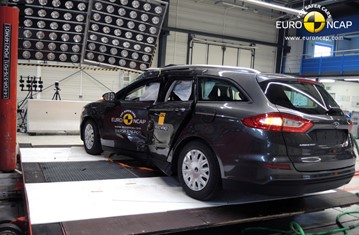



The passenger compartment remained stable in the frontal impact. Dummy readings indicated good protection of the knees and femurs of the driver and passenger. Ford showed that a similar level of protection would be provided to occupants of different statures and to those sat in different positions, whose knees might contact the dashboard in different places. In the side barrier test, protection of all critical body regions was rated as good except for the chest, protection of which was adequate. In the more severe side pole test, protection of the chest was marginal. Tests on the front seats and head restraints, and a geometric assessment of the rear seats, indicated good protection against whiplash injuries for all seating positions. An autonomous emergency braking system is available as an option, and works at low speeds typical of city driving. As it is not standard equipment, it was not included in this assessment.